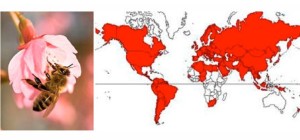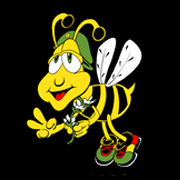Save the Bees
A short video produced by Burt’s Bees to explain CCD.
Comments Off
Source: The Xerces Society
Approximately four thousand species of bees are native to the United States. These wild insects provide crop pollination services, and are often specialized for foraging on particular flowers such as tomatoes, squash, berries, orchard, or forage crops. This specialization results in efficient pollination, high yields, and larger fruit.
While the non-native Eurpoean honey bee (Apis mellifera) is the most important managed crop pollinator, its numbers are in decline because of disease and other factors. This makes native bees, which contribute an estimated $3 billion worth of crop pollination annually to the U.S. economy, more important than ever. Native bees are of particular importance to organic farming because unlike honey bees, their populations can be supported without the use of antibiotics and other chemical inputs.
The reduced use of pesticides, as well as more sustainable management practices, makes organic farms an important asset in protecting our national pollinator resources. Many organic operations already have good numbers of wild bees. In some cases, these native bees can effectively provide all necessary crop pollination services when adequate habitat is available and bee-friendly management practices are implemented.
Unfortunately, however, even pesticides approved for organic agriculture can cause significant harm to bees. This fact sheet provides a brief overview of how to select and apply pesticides for organic farm operations while minimizing pollinator mortality. Keep in mind that the same practices outlined here that help protect pollinators also may protect beneficial insects such as parasitoid wasps, predacious flies and beetles, ambush and assassin bugs, lacewings, and others. The presence of these insects can further reduce pest pressure and the need for chemical treatments.
Comments Off
Source: The Xerces Society
Organic farming offers many benefits to pollinators but some common organic-approved pesticides and practices can be potentially just as harmful to bees and other pollinators as conventional farming systems.
For example, in the absence of readily available herbicides, some organic farms depend more heavily on tillage as a primary weed control strategy. This greater soil disturbance may be detrimental to ground-nesting bees.
Comments Off
Pesticide issues in the works: Honeybee colony collapse disorder
Current as of February 18, 2011
Source: EPA Website
Discovering a problem
During the winter of 2006-2007, some beekeepers began to report unusually high losses of 30-90 percent of their hives. As many as 50 percent of all affected colonies demonstrated symptoms inconsistent with any known causes of honeybee death: sudden loss of a colony’s worker bee population with very few dead bees found near the colony. The queen and brood (young) remained, and the colonies had relatively abundant honey and pollen reserves. But hives cannot sustain themselves without worker bees and would eventually die. This combination of events resulting in the loss of a bee colony has been called Colony Collapse Disorder (CCD).
Though agricultural records from more than a century ago note occasional bee “disappearances” and “dwindling” colonies in some years, it is uncertain whether the colonies had the same combination of factors associated with CCD. What we do know from the most recent data from beekeepers for 2009 is that that CCD appears to still be with us.
Dead bees don’t necessarily mean CCD
Certain pesticides are harmful to bees. That’s why we require instructions for protecting bees on the labels of pesticides that are known to be particularly harmful to bees. This is one of many reasons why everyone must read and follow pesticide label instructions. When most or all of the bees in a hive are killed by overexposure to a pesticide, we call that a beekill incident resulting from acute pesticide poisoning. But acute pesticide poisoning of a hive is very different from CCD and is almost always avoidable.
There have been several incidents of acute poisoning of honeybees covered in the popular media in recent years, but sometimes these incidents are mistakenly associated with CCD. A common element of acute pesticide poisoning of bees is, literally, a pile of dead bees outside the hive entrance. With CCD, there are very few if any dead bees near the hive. Piles of dead bees are an indication that the incident is not colony collapse disorder. Indeed, heavily diseased colonies can also exhibit large numbers of dead bees near the hive.
Why it’s happening
There have been many theories about the cause of CCD, but the researchers who are leading the effort to find out why are now focused on these factors:
• increased losses due to the invasive varroa mite (a pest of honeybees);
• new or emerging diseases such as Israeli Acute Paralysis virus and the gut parasite Nosema;
• pesticide poisoning through exposure to pesticides applied to crops or for in-hive insect or mite control;
• bee management stress;
• foraging habitat modification
• inadequate forage/poor nutrition and
• potential immune-suppressing stress on bees caused by one or a combination of factors identified above.
Additional factors may include poor nutrition, drought, and migratory stress brought about by the increased need to move bee colonies long distances to provide pollination services.
Comments Off

‘The fact is that of the 100 crop species that provide 90 per cent of the world’s food, over 70 are
pollinated by bees. Human beings have fabricated the illusion that in the 21st century they have the
technological prowess to be independent of nature. Bees underline the reality that we are more, not
less dependent on nature’s services in a world of close to seven billion people.’
Comments Off
